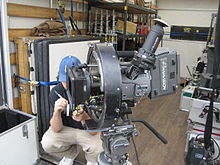- Dutch angle
-
Dutch tilt, Dutch angle, Dutch shot, oblique angle, German angle, canted angle, Batman angle, or jaunty angle (in non-cinematic static photography) are terms used for one of many cinematic techniques often used to portray the psychological uneasiness or tension in the subject being filmed. A Dutch angle is achieved by tilting the camera off to the side so that the shot is composed with vertical lines at an angle to the side of the frame. Many Dutch angles are static shots, but in a moving Dutch angle shot the camera can pivot, pan or track along the director/cinematographer's established diagonal axis for the shot.
A special Dutch Angle is the Bavarian Angle, where the camera position is changed about 90° from the common angle. Horizontal lines become vertical.
A Dutch angle differs from a high-angle shot and low-angle shot (although Dutch angle shots are often combined with those for artistic and/or dramatic effect), in that those refer to placement of the camera in height relative to the subject (which for human subjects is mostly defined by a person's eyeline).
In non-cinematic static photography a Jaunty angle can add a new variance to otherwise vertical/horizontal framing. Obtuse and acute angles can be added to dull pictures by means of tilting the camera prior to use. This effect can make a picture appear on a slope bringing to it a feeling of creativity and making the whole aesthetic more attractive. The term 'jaunty' was popularised by use with hats being placed at an inclined angle and this term has been adopted in the early 21st century by those using their camera on a similar incline.
Examples of usage in movies
Dziga Vertov's 1929 experimental documentary Man with a Movie Camera is known to contain one of the first usages of the Dutch angle, among other innovative techniques discovered by Vertov himself.
The angle was widely used to depict madness, unrest, exoticness, and disorientation in German Expressionism, hence its name (Deutsch, meaning German, was often conflated with the etymologically identical word Dutch; compare Pennsylvania Dutch). Montages of Dutch angles are structured in a way that the tilts are almost always horizontally opposite in each shot, for example, a right tilted shot will nearly always be followed with a left tilted shot, and so on.
The 1949 film The Third Man makes extensive use of Dutch angle shots, to emphasize the main character's alienation in a foreign environment. An anecdote of cinema lore alleges that once filming was completed, the crew presented director Carol Reed with a spirit level, to sardonically encourage him to use more traditional shooting angles.[1]
Dutch angles were used extensively in the original TV series and 1966 film of Batman, where each villain had his or her own angle. Scenes filmed in any villain's hideout, when only the chief villain and his or her henchmen were present, were invariably shot at an angle departing extremely from the horizontal. This was to show that the villains were crooked.
Dutch angles are frequently used by film directors who have a background in the visual arts, such as Tim Burton (in Edward Scissorhands, and Ed Wood), and Terry Gilliam (in Brazil, The Fisher King, Twelve Monkeys, Fear and Loathing in Las Vegas and Tideland) to represent madness, disorientation, and/or drug psychosis. In the The Evil Dead trilogy, Sam Raimi used Dutch angles to show that a character had become possessed.
The Dutch angle is an overt cinematographical technique that can easily be overused. The science-fiction film Battlefield Earth (2000), in particular, drew sharp criticism for its pervasive use of the Dutch angle. In the words of film critic Roger Ebert, "the director, Roger Christian, has learned from better films that directors sometimes tilt their cameras, but he has not learned why."[2]
James Cameron "Dutched" the camera during the final stages of the sinking in his film Titanic, but here the intent was not to produce a sense of unease, but rather to exaggerate the slant of the deck, which—because of its length, and the need for sections of it to submerge—could only be tilted by an angle of about 6 degrees.
The Cable Guy (1996) uses the Dutch angle to foreshadow the disturbed personality of Chip Douglas (Jim Carrey).
Fay Grim (2006) was shot almost entirely in Dutch angles.
Doubt (2008) uses Dutch angles in many shots to show the tension of the scenes.
See also
References
- ^ Charles Thomas Samuels, Encountering Directors, 1972 - interview with Carol Reed, excerpt at wellesnet.com
- ^ Ebert, Roger (2000-05-12). "Battlefield Earth". Chicago Sun-Times. http://rogerebert.suntimes.com/apps/pbcs.dll/article?AID=/20000512/REVIEWS/5120301/1023. Retrieved 2006-07-29.
Categories:- Film techniques
- Television terminology
Wikimedia Foundation. 2010.

